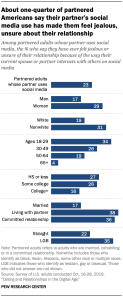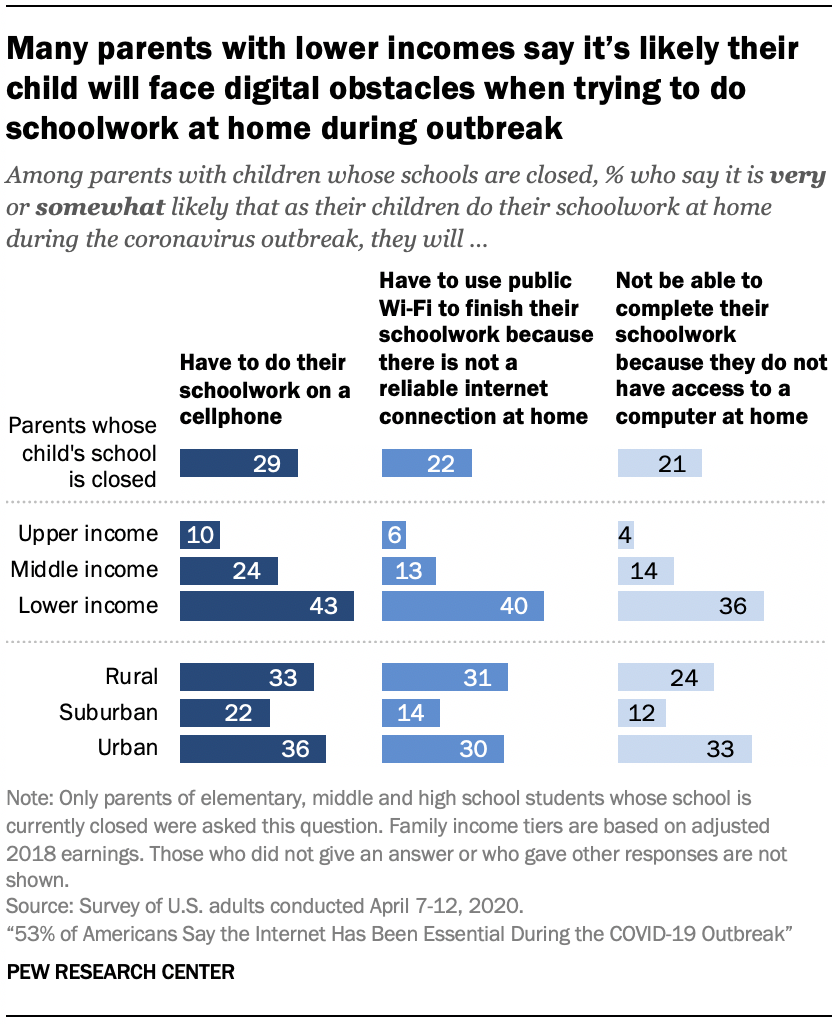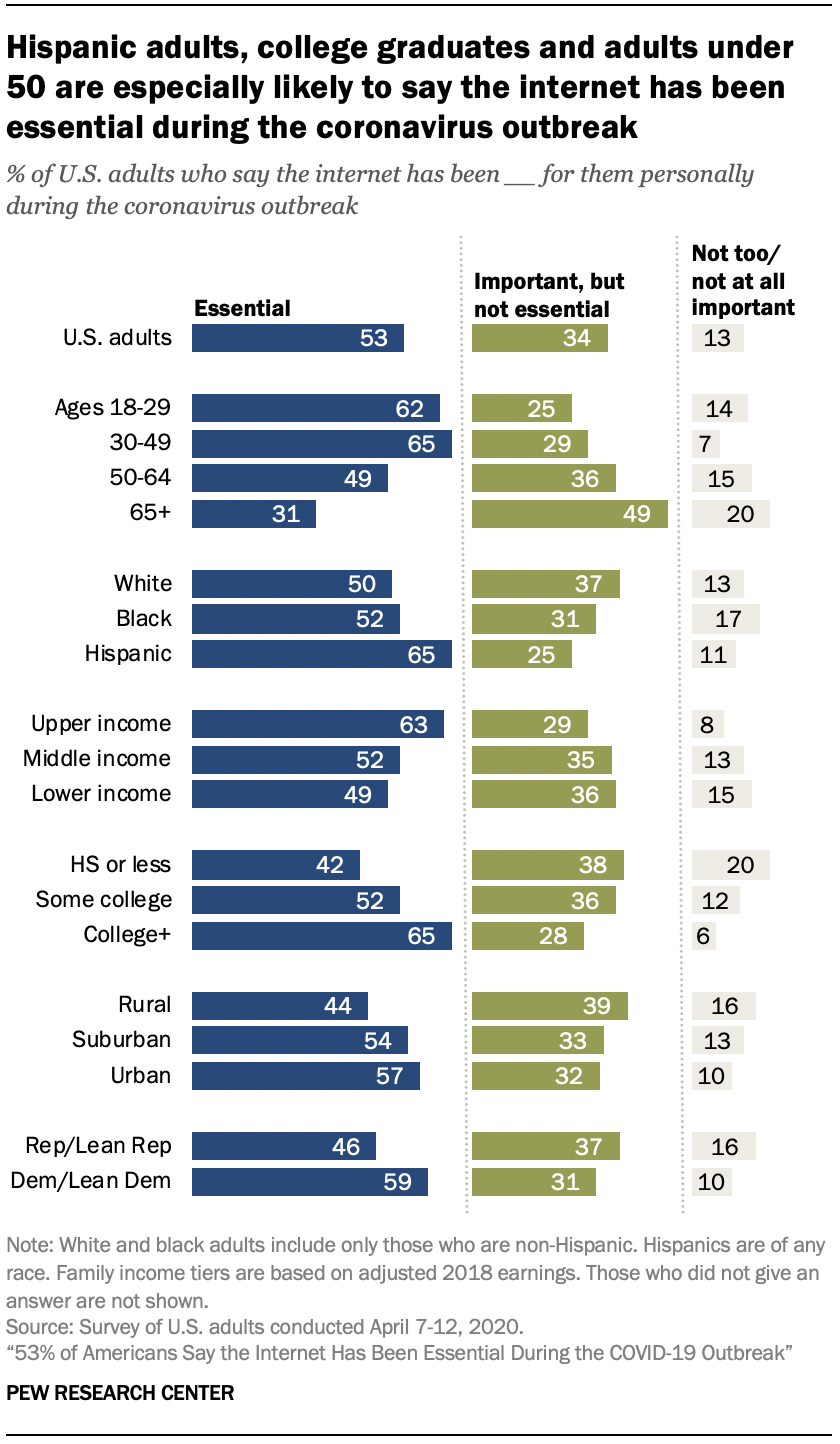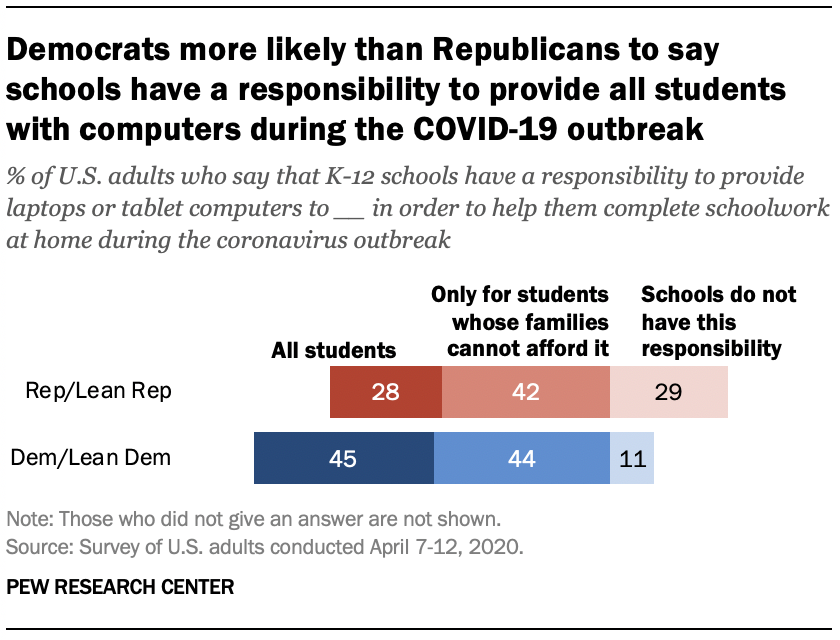

How we did this
Pew Research Center conducted this study to understand how Americans think about the role of the internet and cellphones amid the coronavirus outbreak. For this analysis, we surveyed 4,917 U.S. adults from April 7 to 12, 2020. Everyone who took part is a member of Pew Research Center’s American Trends Panel (ATP), an online survey panel that is recruited through national, random sampling of residential addresses. This way nearly all U.S. adults have a chance of selection. This gives us confidence that any sample can represent the whole U.S. adult population (see our Methods 101 explainer on random sampling). The survey is weighted to be representative of the U.S. adult population by gender, race, ethnicity, partisan affiliation, education and other categories. Read more about the ATP’s methodology.
Portions of this analysis cover different income groups. To create the upper-, middle- and lower-income tiers used in this report, family incomes based on 2018 earnings were adjusted for differences in purchasing power by geographic region and for household sizes. Middle income is defined as two-thirds to double the median annual income for all panelists. Lower income falls below that range; upper income falls above it. For more information about how the income tiers were determined, please read this.
See here to read more about the questions used for this report and the report’s methodology.
The coronavirus outbreak has driven many commercial and social activities online and for some the internet has become an ever more crucial link to those they love and the things they need.

A new Pew Research Center survey conducted in early April finds that roughly half of U.S. adults (53%) say the internet has been essential for them personally during the pandemic and another 34% describe it as “important, but not essential.”
As Americans turn to the internet for critical purposes, there are rekindled debates about how the digital divide – that is, the gap between those who do or do not have access to technology – may hinder people’s ability to complete everyday tasks or even schoolwork. Most recently, President Donald Trump announced plans to address broadband connectivity in future economic relief efforts related to the outbreak.
The new national survey of 4,917 U.S. adults conducted April 7 to 12 using the Center’s American Trends Panel explores public attitudes about the role of government in addressing these issues and finds that a majority of Americans (62%) do not think it is the federal government’s responsibility to ensure that all Americans have a high-speed internet connection at home during the COVID-19 outbreak. And a similar share (65%) do not think the federal government should be responsible for ensuring cellphone services to all.
There are partisan differences when it comes to views about the government’s role in ensuring internet and mobile connectivity during this time. Roughly half of Democrats and independents who lean to the Democratic Party (52%) say it is the federal government’s responsibility to ensure that all Americans have a high-speed internet connection at home during the outbreak, and 45% think it is the government’s responsibility to ensure that people have cellphone services. By comparison, smaller shares of Republicans and Republican-leaning independents hold this view about the government ensuring home broadband access (22%) or cellphone services (21%).
As most schools around the nation have closed and classes and assignments have shifted online, some policymakers have raised concerns about how less digitally connected students will fare in this new learning environment.

When asked about the role of schools in providing technology to students, 37% of adults say K-12 schools have a responsibility to provide all students with laptop or tablet computers in order to help them complete their schoolwork at home during the COVID-19 outbreak. And 43% think schools have this responsibility, but only for students whose families cannot afford it. In total, 80% of Americans think schools have this obligation to at least some students, while about one-in-five (19%) say they do not have this responsibility to any students.
While majorities of both Democrats and Republicans – including independents, who lean towards these parties – believe that schools have a responsibility to provide technology to at least some students to help them complete their schoolwork, there are partisan differences when it comes to the idea of providing laptops or tablets to all students. Some 45% of Democrats believe schools should be obligated to provide computers to all students during the outbreak, compared with 28% of Republicans. Meanwhile, Republicans are more likely than Democrats to believe schools do not have a responsibility to provide computers to any students (29% vs. 11%).
Amid concerns that students’ learning may be harmed due to the widespread school closures, the early April survey also finds that 94% of parents who have children in elementary, middle or high school say their children’s school is currently closed due to the outbreak. And a portion of these parents say it is at least somewhat likely their children will struggle with schoolwork because of technology limitations.

Overall, roughly one-in-five parents with homebound schoolchildren say it is very or somewhat likely their children will not be able complete their schoolwork because they do not have access to a computer at home (21%) or have to use public Wi-Fi to finish their schoolwork because there is not a reliable internet connection at home (22%). And about three-in-ten parents (29%) report that it is at least somewhat likely their children will have to do their schoolwork on a cellphone.
These concerns are especially prevalent among parents with lower incomes.1 Some 43% of lower-income parents with children whose schools shut down say it is very or somewhat likely their children will have to do schoolwork on their cellphones; 40% report the same likelihood of their child having to use public Wi-Fi to finish schoolwork because there is not a reliable internet connection at home, and about one-third (36%) say it is at least somewhat likely their children will not be able to complete schoolwork because they do not have access to a computer at home.
At the same time, rural and urban parents whose children’s schools have closed are more likely than their suburban counterparts to think that it is at least somewhat likely their children will struggle with their schoolwork because of lack of digital resources at home.
This survey conducted April 7 to 12 also covered another key aspect of the digital divide: whether Americans are worried about their ability to pay their internet or cellphone bills over the coming months.2 Some 28% of those who have a high-speed connection at home say they worry a lot or some about paying for this service over the next few months, and 30% of smartphone owners say they worry at least some about paying their cellphone bill. Hispanic or black broadband or smartphone users and those with lower incomes are especially likely to say they worry about these types of bills.
The vast majority of Americans view the impact of the internet positively, and nearly nine-in-ten say it’s been an essential or important tool during the coronavirus outbreak
There is evidence that some people are using the internet more in the midst of the coronavirus outbreak and that new kinds of online activities are gaining popularity. The early April survey examines how this might be affecting people’s overall views about the role of the internet in their lives and in society, more broadly.

Asked to state their views when they add up all the advantages and disadvantages of the internet for them personally, nine-in-ten Americans say the internet has mostly been a good thing for them. At the same time, 78% believe it has been a mostly good thing for society. As has been true in previous Center surveys, the public is more likely to say the internet has been a bad thing for society than a bad thing for them personally (21% vs. 10%). This overall positive view of the internet is shared by vast majorities across each of the major demographic groups surveyed.

Americans were also asked how important the internet has been for them during the coronavirus pandemic. Fully 87% of adults say the internet has been at least important for them personally during the coronavirus outbreak, including 53% who describe it as essential. Relatively few Americans – 13% – think the internet has been not too or not at all important for them during the outbreak.
Majorities across all demographic groups consider the internet at least important during this time, but there are some distinctions on whether they have found it be essential. Roughly two-thirds of adults under the age of 50 say the internet has been essential for them during the outbreak, compared with 49% of adults ages 50 to 64 and 31% of adults age 65 and older.
There are also some differences by education level. Some 65% of college graduates say the internet has been essential during the outbreak, compared with 52% of adults with some college education and 42% of those with a high school education or less. Upper-income adults, Hispanics, and urban or suburban residents are also particularly likely to describe the internet as essential for them during the coronavirus outbreak.
Roughly half of Americans with lower incomes are worried about paying their broadband and cellphone bills over the coming months
With numerous everyday tasks being driven online, there is renewed attention on the impact of the digital divide. Before the pandemic, Center surveys showed that there is still a share of the population that is not digitally connected in some way.

Other Pew Research Center reports show that many Americans face substantial new financial struggles because of this outbreak. About half say the coronavirus poses a major threat to their personal finances, and, as of early April, 43% of Americans say that someone in their household has lost their job or experienced a pay cut.
In light of this, the new survey asked digital technology users how worried they are about being able to pay for their high-speed internet connection in their home and the cellphone services over the next few months. Some 28% of home broadband users say they have some (19%) or a lot of worry (9%) about affording this expense over the next few months. And 30% of smartphone users say they worry a lot (11%) or some (18%) about paying their cellphone bills.
Americans with lower incomes are especially likely to express concern about broadband and cellphone bills. Roughly half of lower-income broadband users (52%) say they worry a lot or some about being able to pay for their high-speed internet connection over the coming months, compared with 26% of those with incomes in the middle and just 9% of those in the high-income tier. Among smartphone owners, 54% of those who have lower incomes say they worry at least some about paying their cellphone bills, compared with 25% of those who are middle income and just 9% of upper-income users.
At the same time, Hispanic adults are particularly likely to express concerns about paying their tech-related bills. For example, 54% of Hispanic broadband users say they worry about being able to pay for their home internet services, compared with 36% of black users and 21% of white users. Similar patterns are present when asked about worries related to paying cellphone bills over the next few months, with Hispanic smartphone owners being more likely than their black or white counterparts to say they worry about this.
There are also some differences by age. Broadband and smartphone users ages 18 to 64 are more likely than those ages 65 and up to say they worry about being able to pay their internet or cellphone bills.
Democrats are more inclined than Republicans to believe the government has a responsibility to ensure internet and mobile connectivity during this time
A central question in the digital divide debate is what role, if any, should government play in helping those without access. More recently, some states have started to subsidize broadband access for those who currently lack access, while President Trump announced plans to tackle connectivity issues during the outbreak.

Overall, a majority of Americans in this early April survey say it is not the responsibility of the federal government to ensure that all Americans have a high-speed internet connection (62%) or cellphone service (65%) amid the pandemic, while about four-in-ten believe that the government should bear this responsibility.
While there is not clear majority support among either party for this, Democrats and independents who lean toward the Democratic Party are more likely than their Republican and Republican-leaning counterparts to believe that the government should have a role in providing these services. Roughly half of Democrats (52%) say the federal government has a responsibility to ensure that all Americans have a high-speed internet connection at home during the COVID-19 outbreak, while just 22% of Republicans hold his view. Democrats are also about twice as likely as Republicans to believe the federal government has responsibility to provide cellphone service for all Americans amid this crisis (45% vs. 21%).
There are also differences within the Republican Party by income. Among Republicans and Republican leaners, 36% of those with lower incomes say the federal government has a responsibility to ensure that all Americans have a high-speed internet connection at home during this pandemic, compared with 20% of those in the middle-income tier and just 13% of those who in the upper income tier. When asked about their views about ensuring cellphone services, 35% of lower-income Republicans and Republican leaners agree that the government bears this responsibility, while smaller shares of middle- and upper-income Republicans say this (19% and 13%, respectively).
By comparison, there are more modest differences found between upper- and lower-income Democrats.
Broadband users who express concern about affording their high-speed internet bill in the coming months are more likely than those who are less worried about their internet connectivity bills to back the idea that the federal government should ensure high-speed internet access during the coronavirus outbreak (52% vs. 31%). Similarly, smartphone users who say they worry about affording their cellphone bills for the next few months are more likely than those who are less worried about their phone bills to say that they think the federal government has a responsibility to ensure that all Americans have cellphone service during the coronavirus (47% vs. 29%).
Americans mostly believe that K-12 schools should provide computers to at least some students during the COVID-19 outbreak
In this more challenging education environment, the question becomes: Should school systems provide technology to K-12 students? When asked about schools’ responsibility to provide laptop or tablet computers to students in order to help them complete their schoolwork at home during the coronavirus outbreak, 37% of Americans say K-12 schools have this responsibility to all students, and 43% say they are only responsible for providing these resources to students whose families cannot afford them. By comparison, 19% believe schools do not have this responsibility to any students.

While majorities of both Democrats and Republicans say schools have the responsibility to provide computers to at least some students, there are partisan differences when it comes to whether this should be available to all students. Democrats and the independents who lean Democratic are more likely than Republicans and their leaners to say schools have this responsibility to all students (45% vs. 28%).
At the same time, 29% of Republicans (compared with 11% of Democrats) say schools do not have a responsibility to provide computers to any students during the COVID-19 outbreak.




